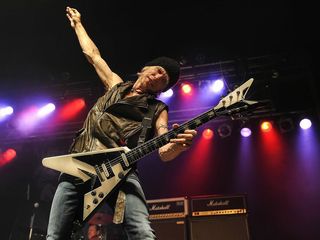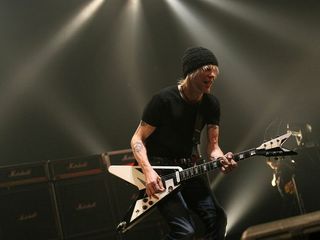
Michael Schenker talks Scorpions, energy and Bridge The Gap
As the guitarist responsible for the steel-hard riffs of tracks such as Lovedrive with the Scorpions and Lights Out with UFO, it’s perhaps surprising that Michael Schenker generally prefers not to look to the past for inspiration.
But, he says, after “something happened” three years ago and he began to draw new energy from live performances, he embarked on a path that led him to a reunion with ex-Scorpions bandmates Herman Rarebell and Francis Buchholz for his new album ‘Bridge The Gap’ – although it took a lucky intervention from Star Trek legend William Shatner to convince him that fate was smiling on the project.
Michael also explains how an unwanted delay in finishing the album actually improved it – even if it caused the band severe pangs of frustration…

William Shatner beams up
How did ‘Bridge The Gap’ come to fruition?
“The whole thing with this line-up, how it all started was just so incredibly weird, you know? I never plan anything but it just kind of develops. Pete Way [former UFO bassist] and Herman Rarebell [ex-Scorpions drummer] and myself were trying to put together a touring project. I hadn’t played UFO material for a while, so we mixed it all up and played out of all these different eras of my career - and tried to put together a live project.
“This goes back to 2011 when I did my //Temple of Rock// album when Michael Voss was singing. I’d kind of decided it was time to make a record. I had no idea what I was doing, except that I had material, so I started putting it down to make a demo and I asked Michael Voss to help me out with some guide vocals, and when he was singing I realised he could actually sing so I was like, Michael, why don’t you sing on the album?
“And so we worked on that and then when I came back and played it to Herman Rarebell and Pete Way they were so impressed by this that they wanted to be the rhythm section and so I had a band at that point.
“Michael Voss had this intro and I said to him it would be great to have an actor with a big voice speaking those words. And the weird thing was that a few days later I get a phone call from William Shatner’s agent asking if I wanted to play on his album and I said ‘This is incredible, this is the guy we want: can you please ask him if he can do the words on my new album?’ and so he did that for me and I played on his record.
“And then I decided maybe this is some kind of sign: maybe I should get some musicians from the past and then most of them were available: Carmine Appice, Simon Phillips, my brother, Paul Raymond, all sorts of great musicians and it ended up being ‘Temple of Rock’.”

Touring troubles
So what happened next?
“Well, when it came down to touring Michael Voss wasn’t available because he’d signed a solo deal! And I thought what am I going to do now? And because I was going to perform ‘the best of Michael Schenker’ all together from my whole career there was like three or four different singers. So I couldn’t actually do a live performance with original singers.
“So it didn’t really matter at the time as long as I could figure it [the touring problem] out. I asked Robin McAuley if he would sing in America, and Michael Voss was available for Japan and Doogie White was available for Europe, so I was able to wing it through that period so that’s how that happened.
“Oh and by the way Doogie White sang ‘Before the Devil Knows You’re Dead’ which became A-play for three months on Planet Rock Radio, and so we crossed paths a few times and eventually decided to do something together anyway.
“And then Pete Way started not doing too well, and so I asked Herman, ‘Why don’t you ask [ex-Scorpions bassist] Francis Buchholz what he’s up to? Because now we’re playing so many songs from Love Drive and so on, it would make more than sense to have as many original Scorpions as possible.
"And Francis was available - he loved the idea, so he joined and from that moment on it went incredibly forward: it was so much fun to be on stage with those guys and the audience were so incredible.”

Writing Bridge The Gap
How did the writing process for ‘Bridge The Gap’ begin?
“I sat down in October 2012 I started writing - and by the end of the year, I play and discover on a regular basis so I always bump into little riffs that I really like, and then I put them on tape and I put them away. And when its time to make a record I listen to what I have and [choose] whatever inspires me straight away - that’s how I get my songs together.
“And so I went into the studio and put down some of the first ideas, put down the click track, the tempo and decided on the arrangement, then went through my ideas step-by-step until all the basic arrangements rhythm guitars were done and added all the other elements to it. And then Doogie had great ideas, and so collectively we decided and chose the best ones, and so slowly but surely the songs were forming.”

Maximum energy
Did your hectic touring schedule help or hinder you?
“We finished the album on the 31 March [2013], and on the 4th we had to be in Russia - so we carried on for the next 3 months and the problem was the album wasn’t going to be released until who knows when? I’ve never had an album sitting there so long. It’s unbelievable – it’s so hard.
“I purposely put it away: I mixed it, mastered it, I put it away. I didn’t even play it to the others and they were actually pissed off about it. But I said ‘I can not play this right now, because it’s not going to be released for such a long time and it’s better to stay away from it and to listen to it later with fresh ears, and not be distracted while on tour, with ‘Oh, I don’t like this or that’: lets just wait, and even better stay away for four or five months and then listen to it again’. We can make final adjustments that are probably very valuable.’”
“And exactly that was what happened: by the time we reached July I eventually played it to them and then we collectively you know, especially having not having heard it for so long, we knew what we could improve. So we re-mixed it we added parts to it as good as we could and we worked with what we had and so it actually worked out pretty good, because I’ve never that done before: had the chance to sit and leave it for a few months - and that’s a long time, and you can really hear something you didn’t hear before. It’s incredible, and so it was a great move but that again was not planned, but the circumstances worked to our advantage, and you know here we are, the album is done, and it sounds great.”
The new album has tremendous energy – what fuelled that?
“It seems like life comes in cycles. I started enjoying myself on stage three or four years ago. It started with an image of beauty: somehow, something happened within myself. I started to enjoy being on stage so much and I didn’t understand why – but I was happy that it was happening.
"I was having feelings of when I was 16, 17, 18 years old. And because I was being more
present
on stage, I’m realising also what needs to be done in order to keep things exciting. And so the new album had to be heavy, melodic with a little bit of darkness. Also, we added more of Wayne’s 7-string and took advantage of that sound to combine the old with the new and so we kind of got a really unique mixture - a very dramatic kind of album, too.”
• For detailed studio insights into recording the guitar tones of Bridge The Gap read a full interview with Michael Schenker in issue 376 of Guitarist magazine

Guitarist is the longest established UK guitar magazine, offering gear reviews, artist interviews, techniques lessons and loads more, in print, on tablet and on smartphones Digital: http://bit.ly/GuitaristiOS If you love guitars, you'll love Guitarist. Find us in print, on Newsstand for iPad, iPhone and other digital readers

"There was water dripping onto the gear and we got interrupted by a cave diver": How Mandy, Indiana recorded their debut album in caves, crypts and shopping malls

"Despite recording some truly iconic albums that became a huge part of pop culture history, he always felt like one of us": Five seminal records Steve Albini worked on

"There was water dripping onto the gear and we got interrupted by a cave diver": How Mandy, Indiana recorded their debut album in caves, crypts and shopping malls

"Despite recording some truly iconic albums that became a huge part of pop culture history, he always felt like one of us": Five seminal records Steve Albini worked on
Most Popular









